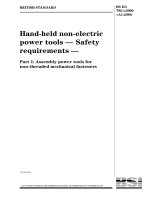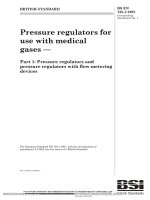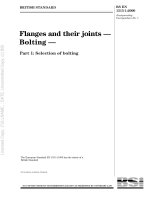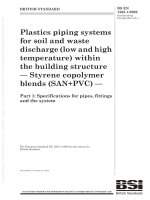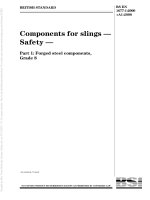Bsi bs en 00806 1 2000 (2002)
Bạn đang xem bản rút gọn của tài liệu. Xem và tải ngay bản đầy đủ của tài liệu tại đây (491.75 KB, 36 trang )
BRITISH STANDARD
Specification for
installations inside
buildings conveying
water for human
consumption Ð
Part 1: General
The European Standard EN 806-1:2000, with incorporation of amendment
A1:2001, has the status of a British Standard
ICS 91.140.60
NO COPYING WITHOUT BSI PERMISSION EXCEPT AS PERMITTED BY COPYRIGHT LAW
| BS EN
|
|
| 806-1:2000
|
| Incorporating
|
| Amendment No. 1
|
|
|
|
|
|
|
|
|
|
|
|
|
|
|
|
|
|
|
|
|
|
|
|
|
|
|
|
|
|
|
|
|
|
|
|
|
|
|
|
|
|
|
|
|
|
|
|
|
|
|
|
|
|
|
|
|
|
|
|
|
|
|
|
|
|
|
|
|
|
|
|
|
|
|
|
|
|
|
|
|
|
|
|
|
|
|
|
|
|
|
|
|
|
|
|
|
|
|
|
|
|
|
|
|
|
|
|
|
|
|
|
|
|
|
|
|
|
|
|
|
BS EN 806-1:2000
National foreword
This British Standard is the official English language version of EN 806-1:2000,
including amendment A1:2001.
The UK participation in its preparation was entrusted by Technical Committee
B/504, Water supply, to Subcommittee B/504/2, Internal systems and components,
which has the responsibility to:
Ð aid enquirers to understand the text;
Ð present to the responsible European committee any enquiries on the
interpretation, or proposals for change, and keep the UK interests informed;
Ð monitor related international and European developments and promulgate
them in the UK.
A list of organizations represented on this subcommittee can be obtained on request
to its secretary.
Cross-references
The British Standards which implement international or European publications
referred to in this document may be found in the BSI Standards Catalogue under the
section entitled ªInternational Standards Correspondence Indexº, or by using the
ªFindº facility of the BSI Standards Electronic Catalogue.
A British Standard does not purport to include all the necessary provisions of a
contract. Users of British Standards are responsible for their correct application.
Compliance with a British Standard does not of itself confer immunity
from legal obligations.
Summary of pages
This document comprises a front cover, an inside front cover, the EN title page,
pages 2 to 32, an inside back cover and a back cover.
The BSI copyright notice displayed in this document indicates when the document
was last issued.
Sidelining in this document indicates the most recent changes by amendment.
This British Standard, having
been prepared under the
direction of the Sector
Committee for Building and Civil
Engineering, was published under
the authority of the Standards
Committee and comes into effect
on 15 November 2000
BSI 17 January 2002
ISBN 0 580 36706 1
Amendments issued since publication
Amd. No.
Date
Comments
13472
17 January 2002
Indicated by a sideline
EUROPEAN STANDARD
EN 806-1
NORME EUROPÉENNE
September 2000
+ A1
EUROPÄISCHE NORM
August 2001
ICS 91.140.60
English version
Specifications for installations inside buildings conveying water
for human consumption - Part 1: General
(includes amendment A1:2001)
Spécifications techniques relatives aux installations pour
l'eau destinée à la consommation humaine à l'intérieur des
bâtiments - Partie 1: Généralités
(inclut l’amendement A1:2001)
Technische Regeln für Trinkwasser-Installationen - Teil 1:
Allgemeines
(enhält Änderung A1:2001)
This European Standard was approved by CEN on 20 January 2000. Amendment A1:2001 was approved by CEN on 29 June 2001.
CEN members are bound to comply with the CEN/CENELEC Internal Regulations which stipulate the conditions for giving this European
Standard the status of a national standard without any alteration. Up-to-date lists and bibliographical references concerning such national
standards may be obtained on application to the Central Secretariat or to any CEN member.
This European Standard exists in three official versions (English, French, German). A version in any other language made by translation
under the responsibility of a CEN member into its own language and notified to the Central Secretariat has the same status as the official
versions.
CEN members are the national standards bodies of Austria, Belgium, Czech Republic, Denmark, Finland, France, Germany, Greece,
Iceland, Ireland, Italy, Luxembourg, Netherlands, Norway, Portugal, Spain, Sweden, Switzerland and United Kingdom.
EUROPEAN COMMITTEE FOR STANDARDIZATION
COMITÉ EUROPÉEN DE NORMALISATION
EUROPÄISCHES KOMITEE FÜR NORMUNG
Central Secretariat: rue de Stassart, 36
© 2000 CEN
All rights of exploitation in any form and by any means reserved
worldwide for CEN national Members.
B-1050 Brussels
Ref. No. EN 806-1:2000 + A1:2001 E
Page 2
EN 806-1:2000
Contents
Page
Foreword ..................................................................................................................................................................... 3
1
Scope.............................................................................................................................................................. 4
2
Normative references ................................................................................................................................... 4
3
Objectives ...................................................................................................................................................... 5
4
Competence and duties for design, construction and operation ............................................................ 5
5
Terms and definitions................................................................................................................................... 5
6
Graphic symbols and abbreviations ........................................................................................................... 8
Annex A (informative) Examples for the use of graphic symbols ....................................................................... 31
Page 3
EN 806-1:2000
Foreword
This European Standard has been prepared by Technical Committee CEN/TC 164, "Water supply", the secretariat
of which is held by AFNOR.
This European Standard shall be given the status of a national standard, either by publication of an identical text or
by endorsement, at the latest by March 2001, and conflicting national standards shall be withdrawn at the latest by
March 2001.
Annex A of this European Standard is informative.
NOTE
This is the first part of the European Standard EN 806 consisting of 5 parts as follows :
EN 806-1, General
EN 806-2, Design
EN 806-3, Pipe sizing
EN 806-4, Installation
EN 806-5, Operation and maintenance
www.bzfxw.com
According to the CEN/CENELEC Internal Regulations, the national standards organizations of the following
countries are bound to implement this European Standard: Austria, Belgium, Czech Republic, Denmark, Finland,
France, Germany, Greece, Iceland, Ireland, Italy, Luxembourg, Netherlands, Norway, Portugal, Spain, Sweden,
Switzerland and the United Kingdom.
Foreword to amendment A1
This amendment EN 806-1:2000/A1:2001 to the EN 806-1:2000 has been prepared by Technical Committee
CEN/TC 164 ‘Water supply’, the Secretariat of which is held by AFNOR.
This European Standard shall be given the status of a national standard, either by publication of an identical text or
by endorsement, at the latest by February 2002, and conflicting national standards shall be withdrawn at the latest
by December 2004.
According to the CEN/CENLEC Internal Regulations, the national standards organizations of the following countries
are bound to implement this European Standard: Austria, Belgium, Czech Republic, Denmark, Finland, France,
Germany, Greece, Iceland, Ireland, Italy, Luxembourg, Netherlands, Norway, Portugal, Spain, Sweden, Switzerland
and the United Kingdom.
Page 4
EN 806-1:2000
1
Scope
This European Standard specifies requirements for and gives recommendations on the design, installation,
alteration, testing, maintenance and operation of potable water installations within buildings and, for certain
purposes, pipework outside buildings but within the premises (see Figure 1).
It covers the system of pipes, fittings and connected appliances installed for supplying potable water.
If there is a private drinking water supply within the property boundary, the scope of this standard also covers the
pipe system from the point of entry from that private water supply.
The sphere of application ends at the downstream end of the potable water installation at which point must be an
air gap, (e. g. at a kitchen tap) or a protection device, (e. g. at a hose union tap).
2
Normative references
This European Standard incorporates by dated or undated reference, provisions from other publications. These
normative references are cited at the appropriate places in the text and the publications are listed hereafter. For
dated references, subsequent amendments to or revisions of any of these publications apply to this European
Standard only when incorporated in it by amendment or revision. For undated references the latest edition of the
publication referred to applies.
EN 805:1999, Water supply – Requirements for systems and components outside buildings.
EN 1717:1999, Protection against pollution of potable water in drinking water installations and general
requirements of devices to prevent pollution by backflow.
www.bzfxw.com
EN 60617-2, Graphical symbols for diagrams – Part 2: Symbol elements, qualifying symbols and other symbols
having general application.
EN 60617-4, Graphical symbols for diagrams – Part 4: Basic passive components.
EN 60617-6, Graphical symbols for diagrams – Part 6: Production and conversion of electrical energy.
prEN 806-2:1996, Specifications for installations inside buildings conveying water for human consumption –
Part 2: Design.
prEN 806-3:1997, Specifications for installations inside buildings conveying water for human consumption –
Part 3: Pipe sizing.
ISO 4063, Welding, and allied processes – Nomenclature of processes and reference numbers.
ISO 6412-1, Technical drawings – Simplified representation of pipelines – Part 1: General rules and orthogonal
representation.
ISO 14617-3, Graphical symbols for diagrams – Part 3: Connections and related devices.
ISO 14617-4, Graphical symbols for diagrams – Part 4: Actuators and related devices.
ISO 14617-5, Graphical symbols for diagrams – Part 5: Measurement and control devices.
ISO 14617-21, Graphical symbols for diagrams – Part 21: Basic mechanical components.
ISO 14617-22, Graphical symbols for diagrams – Part 22: Valves and dampers.
Page 5
EN 806-1:2000
3
Objectives
The main objectives are to ensure that:
¾
the deterioration in water quality within the installation is avoided;
¾
the required flow of water and pressure is available at the draw-off points and at the connection points of
appliances (e. g. water heaters, washing machines);
¾
the potable water meets the standards for physical, chemical and microbiological quality at the draw-off points;
¾
all parts of the installation do not cause danger to health and do not damage property within calculated
lifetimes;
¾
the maintenance of the installation meets the functional requirements at all times during its lifetime;
¾
sound levels are kept to a practicable minimum;
¾
contamination of the public water supply, undue consumption, leakage and misuse is avoided.
4
Competence and duties for design, construction and operation
4.1
Designer
The design shall be carried out by competent persons, e. g. persons with relevant experience, qualifications1) ,
knowledge of regulations and safety requirements.
4.2
Installer
www.bzfxw.com
The work for construction, alteration and maintenance shall be carried out by competent installers in accordance
with qualification required by national or local regulations.
4.3
Water supplier
The data necessary for design and construction (e. g. supply pressure, the supply flow rates and the water quality
analysis at the point of delivery) shall be determined before commencement of work: the information should be
made available by the water supplier (or the operator of a private or separate water supply).
4.4
Operator
The owner/occupier is responsible for ensuring the safe operation and maintenance of the potable water
installation and should be provided with the necessary information.
5
Terms and definitions
For the purposes of this European Standard, the following terms and definitions apply.
5.1
potable water
for the purpose of this specification, potable water shall be suitable for human consumption and conform with the
relevant regulations based on ECC directives
The water may also be used for washing, cooking and sanitary purposes (at temperatures up to 95 °C to allow for
malfunctions).
1)
European regulations to be prepared.
Page 6
EN 806-1:2000
5.2
non-potable water
the collective definition for all kinds of water other than potable water
5.3
potable water installations
for the principal representation see annex A
5.3.1
service pipe
the water pipe which supplies water from the local main to the potable water installation
5.3.2
supply pipe
the water pipe which conducts water from the supply stop valve to connection draw off points and connection points
of appliances
5.3.3
water meter assembly
the water meter assembly comprises the water meter and associated fittings
5.3.4
distributing pipe
distributing pipe means any pipe (other than an overflow pipe or a flush pipe) conveying water from a storage
cistern, or from a hot water appliance supplied from a feed cistern, and under pressure from that cistern
5.3.5
header pipe
the horizontal pipe between the supply stop valve and the rising pipe
www.bzfxw.com
5.3.6
rising (falling) pipe
the part of the pipe (supply or distributing pipe) which leads from floor to floor and from which the floor service pipes
or dead-legs branch off
5.3.7
floor service pipe
the pipe which branches off from the rising (falling) pipe within a floor and from which dead-legs branch
5.3.8
dead-leg
the pipe which is leading to a draw-off point
5.3.9
return pipe
a pipe in a hot potable water circuit in which water returns to the boiler or to the hot water storage vessel
5.3.10
firefighting pipe
firefighting supply pipes with extinguishing devices (e. g. hydrants, sprinklers and water curtains)
5.4
valves
5.4.1
ferrule
a device for connecting a service pipe to the local main. The device may contain a service stop valve
5.4.2
service stop valve
the water suppliers stop valve, which is the first valve in the service pipe after or included in the ferrule
Page 7
EN 806-1:2000
5.4.3
supply stop valve
the first stop valve in the premises which controls the downstream supply and may be included in a water meter
assembly
5.4.4
servicing valve
that valve intended to facilitate maintenance or servicing of a water fitting or appliance
5.4.5
flow reducing valve
a device for reducing the flow by narrowing the cross-section
5.4.6
draw-off point
those points in the potable water installation from which water can be drawn
5.4.7
tap
a valve with an air gap from which water is drawn
5.4.8
drain tap
a tap fitted to drain the contents of the potable water installation or of parts of it
5.4.9
protection unit
a unit to protect the quality of potable water (see EN 1717:1999)
www.bzfxw.com
5.4.10
safety device
a device which operates when dangerous physical operating conditions occur, e. g. excess pressure or
temperature
5.4.11
adjustable control valve
a valve for regulating flow, pressure or temperature
5.5
measuring device
a device for measuring parameters e. g. pressure, temperature or volume
5.6
appliance, equipment
a device in which the potable water is used and/or is modified e. g. water heater, chemical dosing unit,
coffee-machine, WC
5.7
prefabricated unit
a unit comprising assemblies of pipes, fittings, valves, equipment etc., which is assembled off-site and is
transported in complete units to the place of installation
5.8
hydraulic definitions
5.8.1
flow rate
The quotient of the volume of water which is flowing and the time
5.8.2
velocity
the quotient of flow rate and internal cross-section
Page 8
EN 806-1:2000
5.8.3
direction of flow
the direction of flow during normal operation
5.8.4
service pressure (SP)
the internal pressure at the point of connection to the potable water installation at zero flow in the service pipe
5.8.5
lowest normal service pressure (SPLN)
the lowest normal service pressure SPLN means the lowest service pressure at the point of connection occurring
probably during a period of high consumption as estimated by the water supplier
5.8.6
operating pressure (OP)
the internal pressure which may occur at a particular time and at a particular point in the potable water installation
5.8.7
maximum design pressure (MDP)
the maximum hydrostatic pressure at which the potable water installation is designed to work
5.8.8
Nominal pressure (PN)
the maximum hydrostatic pressure at which a component is designed to work at a specified temperature
5.8.9
flow pressure
gauge pressure at a measuring point in the potable water installation system under flow condition
www.bzfxw.com
5.8.10
surge
rapid fluctuation of pressure caused by flow alteration over a short period of time
5.8.11
system test pressure (STP)
The hydrostatic pressure applied to an installation in order to ensure its integrity and tightness
5.9
structure
any structure whether of a permanent character or not, and whether movable or immovable, connected to the water
supplier's mains or to a private water supply. E. g. buildings or part of a building providing accommodation,
including a terraced house, a semi-detached house, a detached house, a flat within any nondomestic premises in a
block of flats, or any other habitable building and any caravan, vessel, boat or houseboat, workshops, offices and
store rooms
5.10
type A installation
closed system: A potable water installation that is under main's or boosted pressure
5.11
type B installation
vented system: A vented system is that part of the system, that is not under main's or boosted pressure
6
Graphic symbols and abbreviations
For ease of reference, certain symbols are illustrated in Figure A.1 and A.2 (see annex A).
NOTE
Symbol infills may be solid or hatched.
No.
6.1
Table 1 — Graphic symbols and abbreviations
Registration
No.
ISO 14617
Pipeline
Description
Pipeline for potable water, cold,
with nominal diameter 80
Graphic symbol
Symbol (S) normative or
example (Ex) informative
Part 3:405
Part 3:405
Water pipes
S
Ex
6.1.1
6.1.2
Part 3:405
Page 9
EN 806-1:2000
Remarks or abbreviations
The asterix shall be replaced
with:
PW
Potable water
PWC
Potable water, cold
PWH
Potable water, hot
PWH-C Potable water, hot,
circulating
NPW
Non potable water
TI
Thermal insulation
Pipeline for potable water, hot,
circulating with nominal
diameter 40
No connection between the two
pipelines exists
Ex
Part 3:405
Two pipelines whose symbols
cross each other
The dot (501) may be omitted.
6.1.3
Part 3:405
T-joint
Pipeline for potable water, hot,
with nominal diameter 50 and
thermal insulation
Ex
Part 3:405,
Ex
6.1.5
Ex
6.1.4
6.1.6
501
The diameter of the dot should be
about 5 times the line (thickest)
line width.
“to be continued”
Registration
No.
ISO 14617
Page 10
EN 806-1:2000
Symbol (S) normative or
example (Ex) informative
Part 3:405,
Table 1 (continued)
No.
Ex
Graphic symbol
6.1.7
Description
S
Part 3:444
Part 3:444
Potable water, cold, hose pipe,
nominal diameter 15
Flexible pipeline, hose pipe
Connection between two
pipelines
6.1.8
Ex
Reduction of pipeline from
nominal diameter 50 to 40
501
6.1.9
Part 3:405,
501
Part 3:405,
-
Pipeline going to a storey
above
Pipe shown in plan
Change of material from steel
to copper
Change of design pressure
from 1,0 MPa to 0,6 MPa
Ex
Ex
6.1.10
6.1.11
501
Part 3:405,
S
-
Ex
6.1.13
S
-
6.1.12
6.1.14
S
501
6.1.15
Pipeline going to a storey
below
Remarks or abbreviations
The dot (501) shall not be
omitted.
The method may be replaced
with two T-joints.
The break point indicates the
location.
The angle between the two parts
is arbitrary.
The flow direction may be
indicated; see below.
“to be continued”
Graphic symbol
Table 1 (continued)
Description
Flow to a storey above
No.
242
Flow from a storey above
Registration
No.
ISO 14617
Ex
242
Flow to a storey below
Symbol (S) normative or
example (Ex) informative
6.1.17
Ex
242
Flow from a storey below
-
6.1.18
Ex
242
S
6.1.19
Ex
-
6.1.16
6.1.20
Ex
Pipeline going between a
storey above and a storey
below
6.1.21
6.1.24
6.1.23
6.1.22
S
S
S
Ex
Part 3:532
Part 3:531
see remark
Part 3:325,
511
Expansion sleeve, sliding joint
Expansion loop
Earth
Electrically isolating device
T-joint with one branch going to
a storey above and the other
branch going to a storey below.
6.1.25
Page 11
EN 806-1:2000
Remarks or abbreviations
IEC 617-02-15-01
Equipotential bond
“to be continued”
6.1.26
No.
S
S
Symbol (S) normative or
example (Ex) informative
-
-
-
Registration
No.
ISO 14617
Sealed wall duct
Wall duct
Guide bracket
Anchor point
Page 12
EN 806-1:2000
6.1.27
S
-
Table 1 (continued)
6.1.28
S
Part 3:518
Fall (slope, descent) to the right
Description
6.1.29
S
-
Fall to the left, 5 %
Graphic symbol
6.1.30
S
-
Joint
End cap
6.1.31
Ex
Joints and coupling connections
S
Part 3:501
6.1.32
6.2
6.2.1
Remarks or abbreviations
“to be continued”
Graphic symbol
Table 1 (continued)
No.
Description
Screwed joint
Registration
No.
ISO 14617
Part 3:514
Flanged joint
Symbol (S) normative or
example (Ex) informative
S
Part 3:511
Clamped flanged joint
Joint of specified type
6.2.3
S
Part 3:513
Part 3:501
6.2.4
S
Part 3:515
Ex
6.2.5
S
6.2.2
6.2.6
Welded, brazed or soldered
joint
Page 13
EN 806-1:2000
Remarks or abbreviations
The asterix shall be replaced
with:
BR
Brazed joint
CP
Compression joint
SC
Screwed joint
SL
Soldering joint
AD
Adhesive joint
WE Welded joint
CR Crimped joint
FL
Flanged joint
CFL Clamped flanged joint
QC Quick release coupling
QCF Quick release coupling
with fastening thread
QCI Quick release coupling
with two identical parts
PF
Push fit
Alternatively, some of the types
may instead be represented by
special symbols, see below
The asterix shall be replaced with
a number code in accordance
with ISO 4063
“to be continued”
Symbol (S) normative or
example (Ex) informative
Part 3:583,
584
Registration
No.
ISO 14617
Quick release coupling with two
identical parts
Quick release coupling
Description
Page 14
EN 806-1:2000
No.
S
Part 3:585
Table 1 (continued)
6.2.7
S
Graphic symbol
6.2.8
6.3.4
6.3.3
6.3.2
6.3.1
S
Ex
S
S
S
Part 22:5121
Part 22:5104
Part 22:5103
Part 22:5103
Part 22:5102
Part 22:5101
Screw -down valve
Four-way valve
Three-way valve used as
mixing valve
Three-way valve
Angled valve
Valve
General purposes valves
6.3.5
S
6.3
6.3.6
Remarks or abbreviations
“to be continued”
6.3.9
6.3.8
6.3.7
No.
S
S
S
S
Symbol (S) normative or
example (Ex) informative
Part 22:5126
Part 22:5125
Part 22:5124
Part 22:5123
Part 22:5122
Registration
No.
ISO 14617
Pressure reducing valve
Disc or butterfly valve
Needle-type valve
Gate-type valve
Plug-type valve
Ball-type valve (spherical
valve)
Table 1 (continued)
6.3.10
S
Part 22:5101
Description
6.3.11
Ex
Graphic symbol
6.3.12
6.3.13
S
S
-
-
90 ° servicing valve
Ferrule
Part 3:131,
261
6.3.14
Page 15
EN 806-1:2000
Remarks or abbreviations
“to be continued”
Page 16
EN 806-1:2000
No.
Symbol (S) normative or
example (Ex) informative
Table 1 (continued)
6.4.4
6.4.3
6.4.2
6.4.1
S
S
S
S
S
-
-
-
-
-
-
Self-closing outlet tap
Mixing outlet tap on wall
Mixing outlet tap in taphole
Mixing outlet tap
Outlet tap on wall
Outlet tap in taphole
Outlet tap
Description
6.4.5
S
-
Shower
Graphic symbol
6.4.6
S
Part 22:5037
Hand-held shower
Registration
No.
ISO 14617
6.4.7
S
Part 22:5037,
444
Outlet taps and related devices
6.4.8
Ex
-
6.4
6.4.9
S
Flushing valve with pipe
interrupter
6.4.10
Remarks or abbreviations
SC Self closing
“to be continued”
Symbol (S) normative or
example (Ex) informative
-
Registration
No.
ISO 14617
Table 1 (continued)
No.
S
Graphic symbol
6.4.11
Part 3:444,
583,
-
Part 22: 5101
584
Ex
Protection units
Ex
6.4.12
6.4.13
6.5
S
Description
Flushing cistern
Valve with quick release
coupling and hose connection
Page 17
EN 806-1:2000
Remarks or abbreviations
Unrestricted air gap
Air gap with overflow
non-circular (unrestricted)
Air gap with submerged
feed incorporating air inlet
plus overflow
Air gap with injector
Air gap with overflow
circular (restricted)
The asterix shall be replaced with
(see EN 1717):
Valve with protection unit, quick Asterix see 6.5
release coupling and hose
connection
Protection unit
AA:
AB:
AC:
AD:
AF:
“to be continued”
Page 18
EN 806-1:2000
No.
Symbol (S) normative or
example (Ex) informative
Graphic symbol
Table 1 (continued)
Registration
No.
ISO 14617
Description
Remarks or abbreviations
AG: Air gap with overflow total by
vacuum or measurement
BA: Backflow preventer with
controllable reduced pressure
zone
CA: Backflow preventer with
different non controllable
pressure zones
DA: In line anti-vacuum valve
DB: Pipe interrupter with
atmospheric vent and moving
element
DC: Pipe interrupter with
permanent atmospheric vent
EA: Controllable antipollution
check-valve
EB: Non controllable anti
pollution check-valve
EC: Controllable anti pollution
double check-valve
ED: Non controllable anti
pollution double check-valve
GA: Mechanical disconnector
direct actuated
GB: Mechanical disconnector
hydraulic actuated
HA: Hose union backflow
preventer
HB: Shower hose union
anti-vacuum valve
“to be continued”


